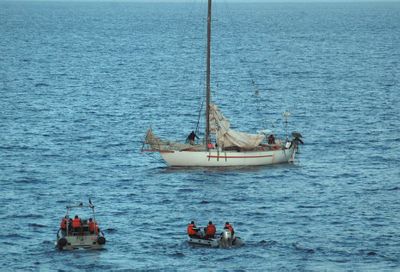Navy biding time in standoff
Rescue attempt by SEALs possible

WASHINGTON – As U.S. Navy warships surrounded the lifeboat where four pirates held an American sea captain hostage Friday, defense officials and analysts said the most likely military option for ending the standoff would not involve any significant use of naval firepower, but rather blocking maneuvers or a discreet operation by elite U.S. sailors.
“We’re not going to do anything rash,” one defense official said as a second Navy vessel, the guided missile frigate USS Halyburton, arrived to join the destroyer USS Bainbridge in the Indian Ocean off Somalia. A third Navy ship is expected to reach the scene within 24 to 48 hours, the officials said.
Using helicopters and unmanned aircraft to keep an eye on the lifeboat and other pirate vessels in the vicinity, the Navy ships were engaged in a strategy of attrition, they said. “Our strategy would be to run them out of options,” said a senior defense official.
Still, defense officials and analysts did not rule out the possibility of a more aggressive, surgical operation by elite Navy SEALs to attempt to rescue the captain, Richard Phillips, 53, of Underhill, Vt.
“I can guarantee you, every possible approach is being planned as we speak,” including a covert rescue operation, said the senior defense official.
The French military decided to use its naval commandos Friday in an operation to rescue two French couples and a 3-year-old boy, after a day of fruitless negotiations with pirates who took the group captive last Saturday aboard a sailing yacht in the Gulf of Aden.
One of the hostages was killed in an exchange of fire, along with two pirates, but the four other captives – three adults and the child – were rescued, President Nicolas Sarkozy’s office announced in Paris. Three pirates were taken prisoner in the operation, and French sailors took control of the sleek vessel, the Tanit, and sailed it toward a Somali port.
U.S. Navy SEALs train regularly to mount such operations, which in this case would require extreme stealth, analysts said. A SEAL team would likely mount a nighttime assault from the sea, they said. Helicopters and boats would be too noticeable, so the SEALs would arrive by swimming and possibly with the aid of submersibles that would allow them to move clandestinely through the water, said Roger Carstens, an expert on U.S. Special Operations forces and a nonresident fellow at the Center for a New American Security.
“It’s within the realm of possibility that a SEAL team could produce a positive outcome,” said Carstens, who served as an Army Special Forces officer. “They could act under cover of darkness after these people are worn out,” he said, referring to the pirates.
Defense officials reiterated Friday that the Navy would thwart any efforts by the pirates in the lifeboat to make contact with other pirate vessels or to reach land, which they said would vastly complicate the rescue effort.
For example, the Navy ships on scene could use blocking techniques to control where the lifeboat goes. One technique, known as “shouldering,” would involve the USS Bainbridge powering alongside the lifeboat to determine its direction. Navy ships could also use their wakes and bow waves to block the lifeboat, the senior defense official said.
“Our job is to make sure the negotiations can continue,” and that is accomplished by keeping the pirates “away from another vessel that might support them, and from the land,” he said.
The pirates have threatened to kill Phillips if the military uses force against them. Phillips made an escape attempt Friday, jumping into the water, but “didn’t make it very far” and was quickly retrieved by the pirates, the official said. Afterward, military surveillance determined that Phillips was “safe and sound.”
Phillips is the skipper of the 17,000-ton Maersk Alabama, which was seized briefly by the pirates Wednesday before the crew regained control. The Maersk is now steaming for Mombasa, Kenya, with a 19-man crew and 18 Navy sailors on board for protection.
France decided on a bolder approach to its hostage situation after a French naval vessel approached the captured sailboat Thursday and began an exchange with the pirates in an attempt to negotiate the hostages’ release, according to the statement from the president’s office in Paris. “Today, threats were more precise, with the pirates refusing proposals and the Tanit moving toward the coast,” it said.
The French defense minister, Herve Morin, said at a news conference that the negotiations included the offer of a ransom. Morin identified the hostage killed in the clash as Florent Lemacon, the father of 3-year-old Colin. He did not describe how Lemacon died.
Florent and Chloe Lemacon had set sail on the Tanit from France’s Brittany region in July with their son, and were joined later by another couple.
The raid marked the third such attack by French forces on Somali pirates who had captured French vessels in the waters off Somalia. France, the United States and other countries have stepped up their anti-piracy efforts in the Gulf of Aden in recent months after pirate attacks nearly tripled in the region from 2007 to 2008, with hundreds of crew members taken hostage and ransoms totaling as much as $30 million last year, according to U.S. data. A naval task force in the area now includes about 23 ships from NATO and other European countries as well as China, India and Russia. It has disarmed more than 250 pirates, releasing about half and turning over the rest for prosecution.